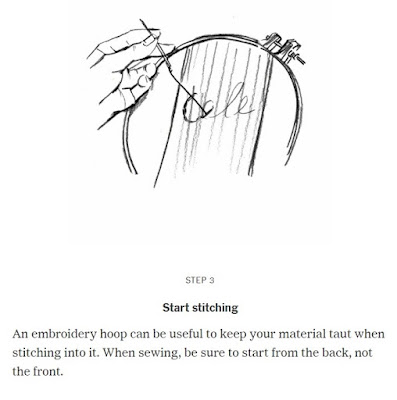Today is Thursday, which means it's time for another well-meaning article in the New York Times Designer DIY feature, in which big names in fashion share silly ideas for people to try at home. I neglected to bring you up to date on last week's feature, so that one first...
Emily Bode, a young luxury menswear designer who "expresses a sentimentality for the past through the study of personal narratives and historical techniques... with female-centric traditions of quilting, mending and applique," teaches us how to fix up a white T shirt to give to your sweetie. First find some thread. "This is a great time to use all of the pre-threaded needles from those miniature hotel mending kits," she says.
Now stitch (loosely, so the shirt can stretch when he puts it on) around the edges of the cuffs, collar and hem. Add a cute heart and writing, if you want. "There's no experience in sewing necessary. The more homemade and messy, the better," she advises.
 |
| illustration: New York Times Thursday Styles section |
Well, not to worry, I suspect every single shirt made from these directions will be messy. Starting with the choice of thread. Two strands of sewing thread, stitched loosely around the neckline, are really going to make a statement. (And unless you were in the habit of spending five night a week on the road in your pre-pandemic job, lifting hotel mending kits right and left, what are you going to use when you run out of them?)
I particularly liked the fact that they illustrated step 5: wash your T shirt to remove the pencil marks. Without that picture, I would have been lost.
 |
| illustration: New York Times Thursday Styles section |
But enough kvetching about last week's project. Today's project uses a T shirt again, but this time to tie-dye it. Our designer-guide is Hillary Taymour, who treats "sustainability as something everyone can practice every day." We're told she has been using tie-dye in her collections for two years, but I would bet money that she doesn't do it the way she advises the readers -- to use beets and turmeric as the dyestuffs.
I checked out what some highly googled websites had to say about using beets for dyeing. What I discovered was that the amateur and mass-media craft sites love them -- beautiful color!!! -- but the people who know a lot about dyeing don't, because the color is notoriously fugitive. In fact, because of that, beets made the list of "Top Five Plants to Never Use for Natural Dyes" on Wearing Woad, a site that reeks of technical competence. Turmeric's reputation isn't much better. But that shouldn't stop our stir-crazy quarantined readers, because they'll add "a splash" of vinegar to the beets to "help your dye hold pigment."
 |
| photo: New York Times Thursday Styles section |
 |
| photo: New York Times Thursday Styles section |
Let the bundle sit for ten minutes before opening, then lay it flat to dry, and "it'll be ready for you to wear the next morning."
Smelling of vinegar.
And kind of wrinkly.
I hope everybody who makes this T shirt enjoys wearing it once or twice. Maybe they'll hit a sweet spot after one or two washes, when the vinegar smell will have disappeared, and the dye won't have disappeared quite yet.
























